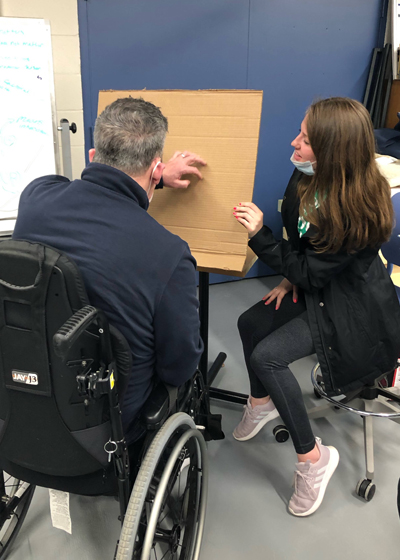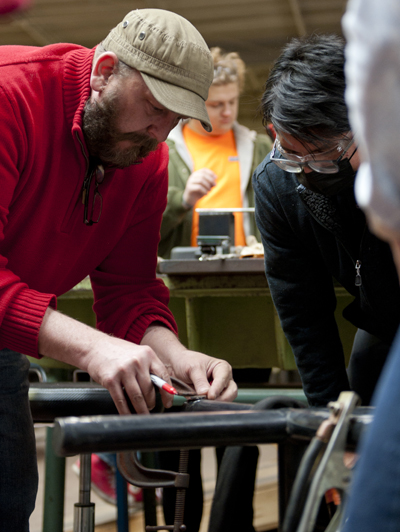Faces on Design provides Nursing, Engineering students with life-changing coursework
As a general manager in the hospitality industry, it wasn’t unusual when Tom Hoatlin received a call to cover a shift. After receiving such a call on Dec. 17, 1991, Hoatlin got dressed, kissed his newborn baby good-bye and made his way to work.
 Not soon after the shift began, two armed robbers held him at gunpoint, eventually shooting him in the base of his neck. Hoatlin was left with a spinal cord injury that resulted in his paraplegia.
Not soon after the shift began, two armed robbers held him at gunpoint, eventually shooting him in the base of his neck. Hoatlin was left with a spinal cord injury that resulted in his paraplegia.
Today, Hoatlin has more than 30 years of experience living with his disability, but in a community that is often overlooked, he still faces problems that the world of engineering and design have yet to solve.
That is where University of Detroit Mercy’s multidisciplinary patient-centered program coined Faces on Design, comes in.
The joint-effort program pairs seniors from the College of Engineering & Science and higher-level Nursing students from the College of Health Professions & McAuley School of Nursing to improve lives by designing a one-of-a-kind assistive device to combat the lack of solutions within the disabled community.
“Often in university research we test subjects that are all university students because that’s who they have access to, but I want these students thinking when they’re designing that there’s other people we need to consider,” said Megan Conrad, Clare Boothe Luce assistant professor of Mechanical Engineering. “We need to be inclusive of our entire community.”
The team of students paired with Hoatlin, has designed a chair lift that will assist him in getting back into his wheelchair, from which he occasionally falls. Another group of students produced a custom easel for Mike Sackey, a client who became a quadriplegic after a bodysurfing accident left him with a spinal cord injury.
“From an engineering perspective, one of the things we struggle with when we teach core courses, is solving open-ended problems,” said Darrell Kleinke, professor of Mechanical Engineering and director of Professional Engineering Programs at Detroit Mercy. “Identifying what the problems are and then designing solutions—it’s really a combination of art and science.
“I would even argue that formulating the problem is just as challenging, if not more challenging, than solving the problem.”
The two-semester course first focuses on meeting with the client, understanding their daily living rituals then collaborating with the client and each other in identifying an obstacle the team of students could help the client overcome.
 The second half of the course involves implementing the team design with a prototype, putting it to the test, and modifying it to fit the client's specific needs.
The second half of the course involves implementing the team design with a prototype, putting it to the test, and modifying it to fit the client's specific needs.
“I never would’ve even thought to have put these two learning curriculums together and now, after experiencing it from start to finish, I just think this is such a staple program, it should be taught in every school,” said Alyssa Nardone, a senior Nursing student.
The collaboration allows Nursing students to implement everything they have learned from pharmacology to community health and be able to relay that to the Engineering students to assist in their design.
“We all have different mindsets and experiences, when the engineers are thinking of building something they’re thinking of keeping it together so that it doesn’t break and I’m thinking of safety concerns,” said Nardone. “We moved away from certain designs because I had the ability and insight to say ‘well this type of model could create pressure ulcers or increases the risk of skin damage,’ a bunch of things that, as a Nursing student, we could prevent before even going down that route.”
Although the course is packed with learning opportunities and freedom to create, it does not come without its complications.
“The biggest challenge that we face is scheduling,” said Molly McClelland, professor of Nursing. “The Engineering curriculum and the Nursing curriculum are on very different tracks, the students have classes at various times so the logistics of getting together can be a challenge. It’s a lot of independent study and work outside of the actual classroom, but this has also proven to be one of the most beneficial parts.
“Oftentimes the teams will meet at the clients' house or outside of the classroom so they’re forming these strong relationships among each other and learning skills that they otherwise wouldn’t learn inside a ‘normal’ classroom setting.”
Though the course is a requirement for Engineering students, it is an elective for Nursing students, so spaces are limited and they fill up fast. Time conflicts and maximizing credit hours forced Raed Farraj, a Pre-Med Electrical Engineering undergraduate, to pass on the second half of the class, but that didn’t stop him from auditing the program he fell in love with.
“I was involved in the first semester so I really wanted to fulfill my obligation to them and see this project through to the end,” said Farraj. “This is extremely multidisciplinary, you have a Nursing student, I’m pre-health, we have electrical engineers and mechanical engineers — what more could you want in an amazing program like this?”
The multidisciplinary class closes with an almost celebratory design presentation event at the end of each school year. But this can also be the most stressful portion.
“Even if you made the greatest project of all time and it doesn’t work for the client, that means you might’ve done a great technical job, but failed at delivering something useful for the client,” said Kleinke. “The Faces on Design title is intended to mean that — it’s the look on the clients face when you’ve delivered that work.
“I think that lesson extends well beyond the course and we hope that when students leave here, they’ll have this experience in mind and think about people with disabilities as they go about their daily job.”
Students and clients are set to meet for their final presentation on April 22 at 10 a.m. in the Engineering Building’s High Bay on the McNicholas Campus.
To learn more about the College of Health Professions & McAuley School of Nursing, please visit https://healthprofessions.udmercy.edu/index.php. For more about the College of Engineering & Science, visit https://eng-sci.udmercy.edu/index.php.
— By Victoria H. Taylor. Follow Detroit Mercy on Facebook, Twitter and Instagram. Have a story idea? Let us know by submitting your idea.
